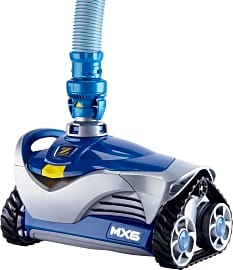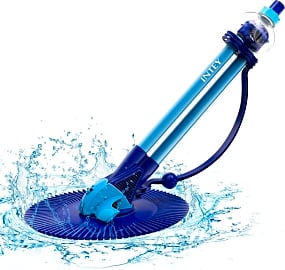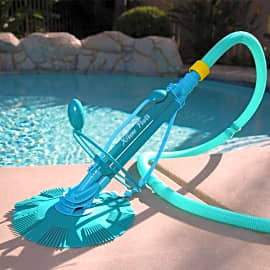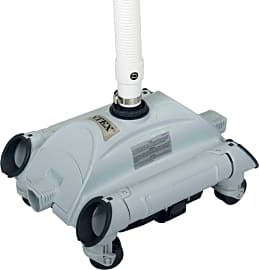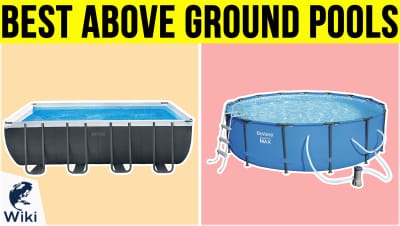The 10 Best Suction Pool Cleaners

This wiki has been updated 36 times since it was first published in October of 2016. A well-made suction pool cleaner will save you from the backbreaking work of doing the job manually. If used regularly, these can also reduce the amount of chemicals you need to use by decreasing the amount of algae floating around and by flushing other contaminants through your filtration system. The right one of these useful machines can get to even hard-to-reach spots. When users buy our independently chosen editorial selections, we may earn commissions to help fund the Wiki.
Editor's Notes
July 13, 2020:
While we did decide on retaining many of our previous selections for this category, we also removed the OAI SkimmerMotion due to availability issues, replaced the XtremepowerUS X5043 with the XtremepowerUS 75037, and changed the Hayward PoolCleaner out for the Hayward AquaNaut 400 — the latter essentially being a replica of the former (which was originally designed by Poolvergnuegen, which was purchased by Hayward in 2013) with some slick-looking cosmetic changes. We also incorporated the Zodiac MX8 into our list — a larger version of the Zodiac MX6 that we recommend for users servicing big pools.
A few things to think about for this category:
Hose: For experienced users who already own a suitable pool vacuum hose, this consideration will be of little relevance. But for new pool owners purchasing equipment for the first time, you’ll want to make sure that, if the pool cleaner you’re considering comes with a hose, it comes with a hose that’s long enough to easily traverse the span of your pool.
With models like the Intex Auto coming with a 24-foot hose, while others like the Zodiac MX8 including a 39-foot hose, there’s quite a bit of variability between options, and the last thing you want is to be stuck with the additional cost of an extra hose, so it’s worth paying attention.
Abilities: The shape, design and functionality of machines in this category can vary just as drastically as the pools they keep clean, so you’ll want to make sure you select one that’s up to the task of servicing your spa.
If you’re looking to take care of a small, barebones, above-ground pool, then you might be able to get away with a basic unit – like the Hayward Wanda the Whale, XtremepowerUS 75037 or Intex Auto – but note that these cleaners will only clean the bottom of your pool, they can’t handle stairs, they’re prone to getting hung up on ladders and other obstacles, and are typically recommended for above-ground pools as they’re not fond of the sloped floors which are indicative of deep ends in in-ground installations.
If you recognize your pool as presenting one or more of those challenges, then you’ll likely want to consider a high-end model like the Zodiac MX8 — which climbs pool walls right up to the waterline, or the Hayward AquaNaut 400 — which is equipped with a four-wheel-drive transmission. They can cost considerably more than their budget-friendly counterparts, but it’s unlikely that you’ll be happy with a less capable model unless you have a suitably small pool.
Style of Cleaner: Since you’ve already found your way to this set of rankings, there’s a good chance that you’ve already narrowed down your choice, and you’re confident that a suction unit is the kind of pool cleaner that you’d like to go with. But, in case your research hasn’t gone that far yet, then there’s a couple other sets of rankings we maintain that you might like to check out.
Pressure pool cleaners work in a manner quite similarly to a suction cleaner, only that instead of hooking up to your filter inlet, they hook up to your return jet, blasting loose particles off the floor of the pool and catching them in a debris bag. And, robotic pool cleaners tend to be some of the best options out there, if you don’t mind inflated up-front costs and additional energy expenses.
June 06, 2019:
A suction side pool cleaner relies on your pool’s pump to collect debris, by connecting to your skimmer via a long hose. This effectively turns it into a vacuum cleaner that will move around your pool automatically, saving you time and effort and providing clean, clear water.
In this update, we added the Intey Vacuum, a highly efficient model that works by way of a rubber disk that moves across the floor, walls, and stairs of your pool to pick up dirt, sand, hair, and more, all of which can be seen in its clear debris cup, so you can easily determine when it needs emptying. It comes with 12 hoses that can be connected together, so chances are you’ll have more than an adequate line. It’s backed by a two-year warranty.
We also added Wanda the Whale, who is sure to entertain your kids as “she” makes her way around your pool. (This selection is also available in fun aquabug and penguin designs.) It’s easy to operate: Just plug the hose into your skimmer, and its steering system takes over and picks up debris effectively. Its bumper ring helps it to move easily around with minimal friction.
The Zodiac Baracuda G3 receives high marks for its quiet operation and powerful motor, and it’s known to handle corners like a champ. It’ll pick up small- to medium-sized debris, including what’s on the walls and steps.
Special Honors
Zodiac MX8 Elite In addition to some minor cosmetic differences, the MX8 Elite separates itself from the company's standard MX8 model with the inclusion of rubber scrub brushes that help kick up debris, so the machine leave less behind while it works. zodiacpoolsystems.com
A Brief History Of Suction Pool Cleaners
This was particularly true in the United States, where the market for home swimming pools exploded in the 1950s.
While swimming pools came to mainstream popularity in the West during the 20th century, the first swimming pool was likely dug in Pakistan between 3000 and 2000 B.C.E.
With respect to form, it was similar to any large contemporary community pool, but the Great Bath was probably used in religious ceremonies, according to historians.
Pools retained this strictly ceremonial role for at least 2,000 years, before the Greeks and Romans began using them for sports and nautical military training. Romans were the first to realize the leisure potential of the pool, and a number of personal swimming pools were built by members of the wealthy set.
The first heated swimming pool was built around 100 B.C.E. by the Roman aristocrat Gaius Maecenas, who notably for the time used the pool for recreation, rather than bathing alone. Maecenas' pool was kept warm by a series of fire pits situated under its floor.
Swimming pools assumed their modern form and function in mid-19th-century Britain, where they were promoted for their health benefits.
After several drownings in an English river, the Maidstone Swimming Club was established in 1844. Today, it is the world's oldest surviving swim club. Numerous other swimming clubs popped up in England in the years that followed the drownings, and by the time the 19th century was over many of the country's indoor baths had been converted to swimming pools.
Swimming continued growing in popularity in the early 20th century, and in 1907 the first swimming pool was installed aboard an ocean liner, and the world's first above-ground swimming pool was built by a Philadelphia racquet club.
A turning point for swimming came a year later in the form of the 1908 Olympic Games — the first modern version of the event. The games pushed swimming from trendy activity to mainstream pastime in England and the United States.
Pittsburgh resident John M. Davison invented the earliest recorded swimming pool cleaner in 1912, calling it a "Cleaning Apparatus For Swimming Pools and the Like." The first suction-side pool cleaner was invented by Chicagoan Roy B. Everson in 1937. Everson called his device, which consisted primarily of a mechanical scoop and filter, simply a "Swimming Pool Cleaner."
After both the First and Second World Wars, returning soldiers used their income and free time to install increasingly affordable personal pools. This was particularly true in the United States, where the market for home swimming pools exploded in the 1950s.
As the home swimming pool industry expanded, so too did the pool maintenance industry. Mid-19th century cleaning tools consisted mostly of either metal or natural brushes and non-specialized brooms, to go along with an array of clumsy suction cleaners. For decades, consumer choices were limited and ineffective.
Finally, in 1967 a so-called robotic cleaner that used electricity was invented by Robert B. Myers of Boca Raton, Florida. Many of today's suction cleaners share a number of traits with Myers' device. Five years later the famed Polaris Pool Cleaner was released. The Polaris paired pressurized, water-dispensing hoses with the automatic functionality of earlier inventions, making it the most effective pool cleaner of its time.
Swimming Pools And Children
Owning a pool is a pleasure, but it is also a serious responsibility, especially when children are in the household.
Among children under age 15, drowning is the second leading cause of injury-related death, according to The National Safety Council.
The good news is that the risk of drowning can be drastically reduced by following a few simple safety tips.
The good news is that the risk of drowning can be drastically reduced by following a few simple safety tips.
First and foremost, never leave a child unattended in or around the pool. Accidents in residential pools and spas account for 80 percent of the 7,000-plus drowning deaths in America annually. Vigilance and, where possible, the employment of a lifeguard can truly save lives.
Whether you own a pool or not, teaching your children to swim is an excellent idea. Aside from the obvious health benefits, swimming can come in handy — and potentially mean the difference between life and death — anytime your child is near a body of water. There are numerous affordable and free public programs on offer by local civic organizations and governments. Similarly, cardiopulmonary resuscitation techniques are taught for free across the world. To find a class near you, visit the American Red Cross website. The quicker CPR is administered to a drowning victim, the better shot they may have at survival.
Your pool's surroundings are also relevant to its safety. When building your pool, refer to the U.S. Consumer Product Safety Commissions guidelines, and build a fence that is at least four feet tall, with alarms at its gates.
Finally, whenever you have guests over, give them a quick safety rundown, and remind them to avoid drains and suction outlets, which can pull in bathing suits or hair. If your drain covers are damaged or missing, do not swim until they are repaired or replaced.
Suction-Side Versus Pressure-Side Cleaners
Today there are primarily two categories of pool cleaning devices: suction-side and pressure-side.
Because it makes use of a secondary pump, the pressure-side cleaner is on average far less efficient than a suction-side cleaner.
Suction-side cleaners use only the water pulled out of the pool by its pump to provide suction and movement. This is regarded as the most popular and affordable pool cleaning technology. While energy-efficient compared to other technologies, most suction-side cleaners can still increase electricity costs by decreasing the effectiveness of a pool's pump, which it uses to filter dirt and leaves from the water.
Pressure-side cleaners use an external pump to pressurize water inflow, which kicks up pool-floor silt and debris. What isn't sucked up by the cleaner itself can then be pulled into the pool's own filtration system.
Because it makes use of a secondary pump, the pressure-side cleaner is on average far less efficient than a suction-side cleaner.
Be aware that either technology can add a burden to your pump, decreasing its lifespan and overall capacity.




